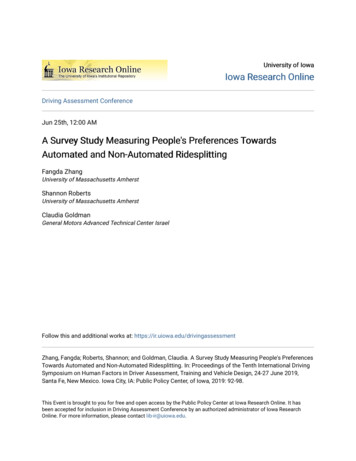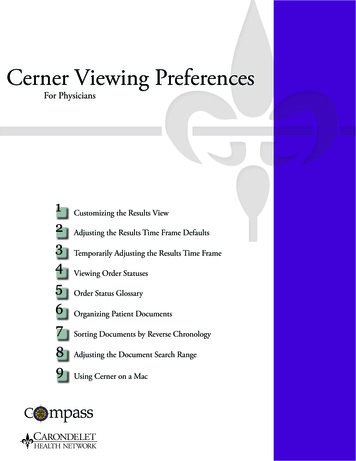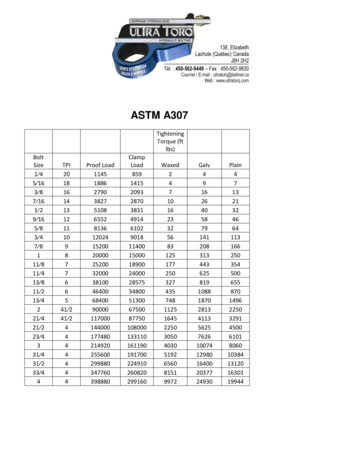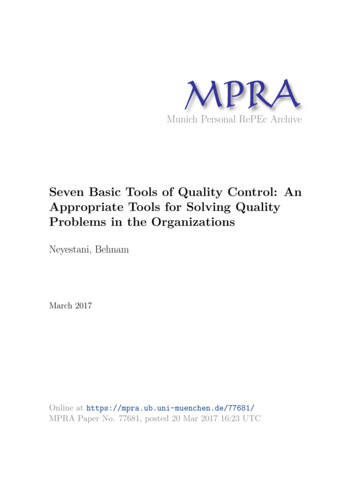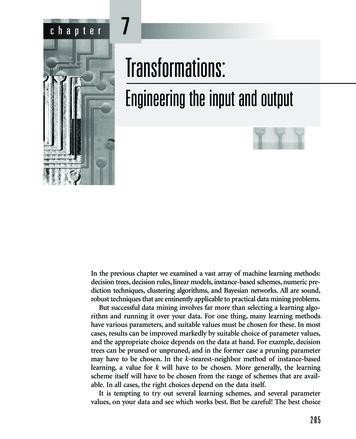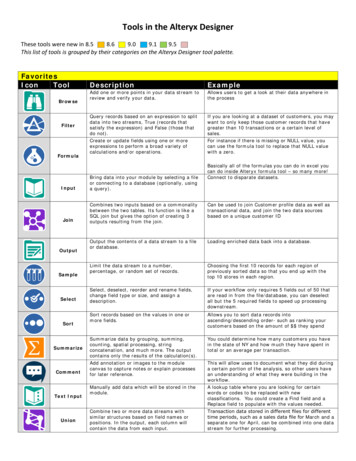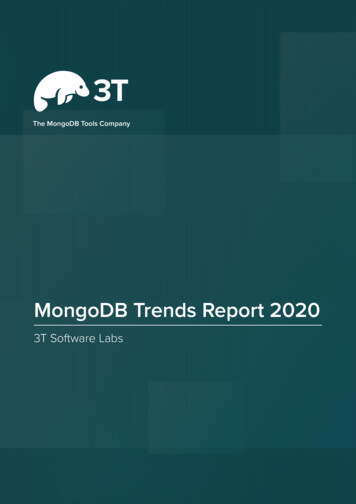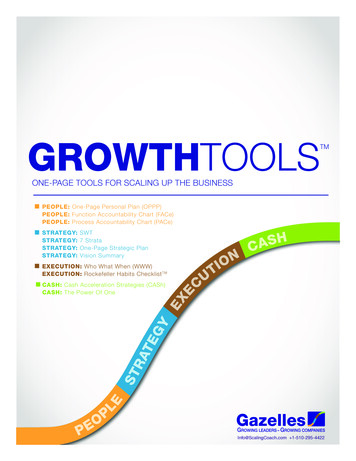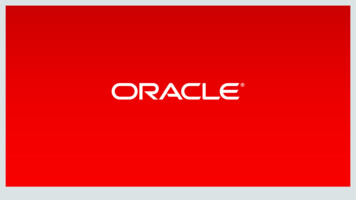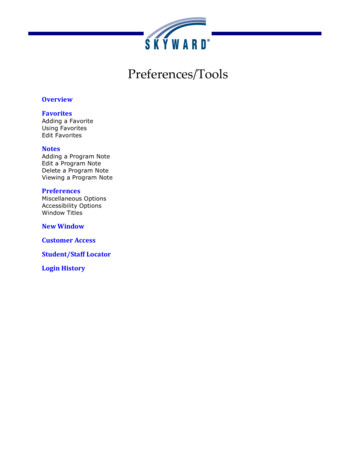
Transcription
Preferences/ToolsOverviewFavoritesAdding a FavoriteUsing FavoritesEdit FavoritesNotesAdding a Program NoteEdit a Program NoteDelete a Program NoteViewing a Program NotePreferencesMiscellaneous OptionsAccessibility OptionsWindow TitlesNew WindowCustomer AccessStudent/Staff LocatorLogin History
OverviewThe Preferences allow you to customize your screens within Skyward. These Preferences arespecific to you and changing them will not affect other users. There are also many Toolsthat you can use throughout the software. The Preferences and Tools can be accessed oneach screen throughout Skyward.The highlighted areas will be covered within this guide and they include: FavoritesNotesPreferencesNew WindowCustomer AccessStudent LocatorLogin History
FavoritesAdding a FavoriteUsing FavoritesEdit FavoritesFavorites allow you to create a shortcut to an area of the software you use frequently.Adding a FavoriteThere are multiple ways in which you can add an area as a Favorite.Clicking on the StarAfter navigating to the specific area in Skyward, you will click on the Star next to the nameof the area.
Once you click on the Star it will turn yellow which is to alert you that this area is flaggedas a Favorite.You can click on the Star to remove it as a Favorite.Using the Favorites MenuA second way of flagging an area as a Favorite is using the Favorites Menu.After navigating to the specific area in Skyward, you will click on the Favorites dropdownand then on the option to Add XXX to Favorites.
After you click on the option to add the area as a Favorite, you will get a screen whichallows you to modify the Description of the Favorite. The Description will default with thearea name. Once the Favorite is saved the Star next to the area name will change to yellow.Using FavoritesYou can access your Favorites by clicking on the Favorites dropdown and selecting theFavorite. After you click on the selected Favorite, you will be taken directly to that area. Youhave the ability to setup shortcut keys for Favorites, which must first be selected in thePreferences. This option will be discussed in the Preferences section of this guide.
Edit FavoritesYou can edit your Favorites by clicking on Edit Favorites in the Favorites Dropdown.When you edit your Favorites, you can modify the description of the Favorite and you alsohave the ability to remove it as a Favorite. You can use theicon to move the Favorites tothe desired number which will modify the Shortcut Key Number and the display order of theShortcut Keys. Favorite Shortcut Key – This option allows you to determine if you want to use aShortcut Key. You can select from either Alt Key (1-9), Ctrl Key (1-9) orNone. The Favorite Shortcut Key is also found in the Preferences.Enable Favorite Heads Up Display – If this option is selected, you can press yourFavorites Shortcut Key to see the Favorites menu instead of having to click on theFavorites Dropdown. You can also find this option within the Preferences.
NotesAdd a Program NoteEdit a Program NoteDelete a Program NoteViewing a Program NoteProgram Notes can be used to keep notes for a specific program area.You can add/edit/delete a Program Note by clicking on the icon that looks like a ‘paper andpencil.’ When a number displays to the right of the icon, it means a Program Note exists.The Program Notes screen allows you to Add, Edit and Delete the Program Notes.
Add a Program Note Summary – Enter the summary of the Program Note; the maximum characters thatcan be entered is 80.Note Details – This area allows you to enter more information regarding theProgram Note.Attachment – You have the ability to add an attachment to the Program Note. Youwill click on the Browse to locate the file.Display For All Users in District – If this option is selected, this Program Note willdisplay for all users with access to this area of the software.Edit a Program NoteWhen you Edit, you can make modifications to all fields of the Program Note.
Delete a Program NoteYou will click on the Program Note to be removed and click on Delete.After clicking on Delete, you will receive a message confirming that you want to delete theProgram Note. You will select Yes to remove the Program Note.Viewing a Program NoteAfter clicking on the ‘paper/pencil’ icon, you can view the Program Note for the specificprogram area. When you expand (click on the arrow) of a Program Note you can view theattachment.
PreferencesMiscellaneous OptionsAccessibility OptionsWindow TitlesThe Preferences can be selected in the upper right hand corner of the screen and will allowyou to setup option associated with your account.
Preferences allow you to setup options associated with your account. Any changes madehere will not affect other users in the software.
Miscellaneous Options Theme Color – This option can be used to change the display color of buttons andmenus within the software. The ability to change your Theme Color is controlled by asetting in the Web Configuration.Display Open/Save Dialog Before Displaying Reports – If this option isunchecked, you will need to display a report first in order to be able to save it.Automatically Open PDF Reports Upon Completion – If this option is selected,PDF reports will automatically display when the Print Queue processing screen isopen.Spreedsheet Format - This option allows you to select what the default formatshould be for spreadsheets generated from Skyward. You can select fromCSV/Microsoft Office 2000, Microsoft Office 2002 or Open Office.
Dim Background When Displaying Alerts – Selecting this option will dim the areaaround an alert box to make the alert more prominent.Above is a sample of the Dim Background When Displaying Alerts option. Maximize Large Windows – This option will force larger windows to open asmaximized to take up the full screen.Look Up Accounts by Account Dimensions – Choosing this option will open theAccount Dimension screen for you to enter each dimension individually rather thanentering the entire account number as a string with all dimension codes included.Automatically Display Popup Browse Details On Mouseover – If this option isselected, information will display when you hold your mouse over a collapsed area ina Browse screen. A collapsed area will display with an arrow pointed to the right.Above is a sample of the option to Automatically Display Popup Browse OnMouseover.
Display Browse Row Numbers – This option will display numbers next to eachrecord when in a Browse screen.Above is a sample with the option to Display Browse Row Numbers. Disable Student indicators – If this option is selected, student indicators will notdisplay Use System Name for Home Menu – If this option is selected, the name of thecurrent system will display in the navigation menu in place of the word ‘Home.’
Above is a sample of the option to Use System for Home Menu. The ‘Home’ hasbeen replaced with ‘Student Management’ system. Display Data Mining Favorites in General Favorites Menu – You can select thisoption to allow Data Mining Reports that have been marked as a Favorite to show inthe Favorites menu and allow then to be printed directly from the Favorites menu.Above is a sample of the option to Display Data Mining Favorites in GeneralFavorites Menu.
Enable Favorites Heads Up Display – If this option is selected, you can displaythe Favorites menu by pressing the designated Favorites Shortcut Key. The Favoritesmenu will display as long as the Shortcut Key is pressed.Above is a sample of the option to Enable Favorites Heads Up Display. You canfind more information regarding the setup of Favorites within this guide. Favorite Shortcut Key – You can select to either use the Control key or the Altkey as a shortcut key to access items that have been marked as a Favorite. Moreinformation regarding the setup of Favorites is found within this guide.Accessibility Options
Show Icon Text – If this option is selected, text will display next to icons thatexplain the purpose of the icon.Above is a sample of the option to Show Icon Text. Use Larger Font Size – You can select this option to display certain areas with alarger font.Above is a sample of the option to Use Large Font Size. You will notice that thefont size has increased so not as much information can display on the screen.
Use High Contrast Color Theme – This option will force the black color theme tobe used to maximize the contrast between items in the background and in theforeground.Above is a sample of the Use High Contrast Color Theme option. Optimize for Screen Readers – If this option is selected, the titles on the browsescreen will be limited to a description of the page. You will also receive a warning toinform you that a pop-up will appear.Above is a sample of the option to Optimize for Screen Readers. In this sample,the Window Title only display the Description instead of the Description, Entity, Path,Menu ID and Release. It also shows a sample of the pop-up warning message.
Use Enhanced Keyboard Navigation – You can select this option to use the tabkey for efficiently moving between fields and pages. When you select this option, itwill begin at the top of the page instead of on the first input field.Above is a sample with the Use Enhanced Keyboard Navigation option selected.In this sample, the first field highlighted is the ‘Account’ and not the attendanceperiods. Display Tooltip for Element with Focus – If this option is selected, a descriptionof the field will display when you use the Tab key on your keyboard to navigate to afield.Above is a sample with the option to Display Tooltip for Element with Focus. Ipressed the tab key on my keyboard and the tooltip for the Course Key fielddisplayed.
Window TitlesThe areas listed here can be moved, using thetool, to change the order in which theinformation displays in the bar at the top of each browser window.Examples of each area using the example above: Description – Profile TabEntity – Entity 400Path – WS\ST\TB\GE\TB\PR\PRMenu ID – 9319Release – 05.14.02.00.00
New WindowThe New Window option allows you to open a new window of Skyward. This option can behandy when you don’t want to close the area you’re currently working in, but want to looksomething up elsewhere in the software. There are two ways to create a New Window.New Window LinkYou can click on New Window to create a second window of this area. After the NewWindow is open, you can navigate to a new area of the software.
Click on the New Window IconThe second way to create a New Window is by clicking on theicon. When you click onthe New Window icon, it will open the screen for that area. In the example above, a NewWindow will open in the Student Browse.
Customer AccessCustomer Access allows you to create service calls to an internal customer access queue forsomeone within the district to answer or submit to Skyward. Depending upon districtprocedures for submitting service calls to Skyward, you may also be able to submit callsdirectly to Skyward by using the Customer Access option.You will find the Customer Access by clicking on the Question Mark in the upper rightcorner of the screen.
After you click on the Question Mark, you will select Customer Access.
Customer Access Menu Path – The Menu Path should reflect where your question is within theSkyward software. It will automatically populate with the menu path where you wereat when you click on ‘Customer Access.’ You must have a Menu Path entered in orderto save the service call. Current Issues/Frequently Asked Questions/Current Release NoteTutorials/Future Release Note Tutorials – You can click on any of the options tosee tutorials related to the entered Menu Path.Submit a Request to Skyward or Internal Queue Type – It is automatically set to Service Call. Contact Preference – You can select your preferred method of contact which iseither Email or Phone. Critical Service Call – This option allows you to flag this service call as critical. Summary – You will enter a Summary of the service call. The maximum charactersyou can enter for the Summary is 50. Detail – The Detail area allows you to include more information related to yourquestion.
Submitting Options Submit to Queue – This option allows you to submit your questions to an internalqueue for your district. You will find the internal queue by going to Product Setup Skyward Contact Access Customer Access.Submit to Skyward – By selecting this option, it will submit the service call toSkyward which will be answered by a customer service representative at Skyward.You will only see this option if you are a Skyward Contact and have a CustomerAccess ID entered.View My Requests – When you select this option, you will be able to view anyservice calls you have submitted.Above is a sample of the View My Requests screen.
Student/Staff LocatorThe Student Locator can be used to look up a student or staff member’s current location aswell as the rest of their schedule for the specific day.You can access the Student Location by clicking on theicon.
Above is a sample of the Student/Staff Locator. If you are on a student or staff record,that person’s schedule will display in the Student/Staff Locator. You can select a differentstudent or staff at the top of the screen by: Clicking on the Student/Staff hyperlinkUsing the Student/Staff dropdown menuEntering the Student/Staff Name Key
Login HistoryThe Login History allows you to review a history of your logins or login attempts.You can find your Login History by clicking on Account.
Within the Account screen, you will click on Login History.
The Login History will display each login and login attempt. You will also be able to see theBrowser, Operating System and IP Address used for each login.
inform you that a pop-up will appear. Above is a sample of the option to Optimize for Screen Readers. In this sample, the Window Title only display the Description instead of the Description, Entity, Path, Menu ID and Release. It also shows
